RIGHT TURN ONLY!!
Sacred Mysteries
by Carlo Santos,

Conventional wisdom tells us that jocks pick on geeks. However, a recent Sports Illustrated piece about the Cleveland Indians mentioned that the team was passing through Boston on a road trip when they had to shack up in a different hotel from their usual one because of an anime convention. Yes, that's right, Anime Boston forced a major league baseball team out of the Sheraton. That's how powerful the fandom is these days. (But hey, the players could have just tried to pass themselves off as cosplaying from a baseball anime...)
BTOOOM!
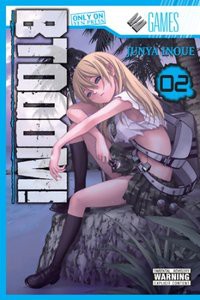
Vol. 2
(by Junya Inoue, Yen Press, $11.99)
FROM THE BACK COVER:
"On a mysterious deserted island, Ryouta Sakamoto, who has been thrust against his will into a vicious game of survival, manages to defeat his first enemy player. While struggling with the guilt of having murdered another person, he stumbles upon Kiyoshi Taira, an older man who fills in some of the blanks about their situation. Ryouta begins to harbor the suspicion that the company behind the virtual 'BTOOOM!' world is also behind this very real bomber death-match. Intent on escape, Ryouta ventures into the heart of this island ... But then, an even more formidable foe attacks!!"
EVIDENCE FOR:
BTOOOM! has already hooked fans with its game-turned-reality premise and survival scenario, but the heart of the series really starts to take shape in Volume 2. This time, Ryouta faces Kousuke, a young opponent who's experienced with the game and has no qualms about killing others. The introduction of Kousuke's character is as arresting as the battle itself, with some stomach-churning scenes that show just how ruthless this kid is. Ryouta and Kousuke's subsequent face-off is hugely entertaining, combining fast-paced action with crafty tactical maneuvers. A war of words between Ryouta and Kousuke, highlighting the difference between their personalities, also intensifies the conflict. Meanwhile, other supporting characters show their intriguing side too: weak-willed Taira may be more cunning than he lets on, and the mysterious girl from before finally enters the story in earnest. Highly detailed backgrounds and page-spanning explosions give the artwork the dose of realism that it needs (despite the fantastical situation), while raw, uncensored gore emphasizes the life-or-death nature of the fight. The story alone is shocking enough, but the art really drives the point home.
EVIDENCE AGAINST:
There's plenty of fun to be had with BTOOOM!, but the excitement feels superficial at best, as the story emphasizes shock value over character development. Kousuke, for example, gets a flashback scene full of parental abuse—but we don't really see the emotional impact of these traumatic moments. It's like bad things simply happen to him, and suddenly, boom! Instant sociopath. Similarly, the friendship between Sakamoto and Taira still isn't convincing: they're operating as a pair, but they only make casual small talk, so it's hard to care about their alliance. A brief scene change, showing the sorry state of Ryouta's parents, also seems like a cheap attempt at "tragedy porn" rather than a genuine show of emotion. (For a survival thriller where the characters' feelings do matter, see the Limit review below.) The artwork, too, relies too much on superficial effects, like the computer-assisted shading for major explosions and textures, plus screentones thrown into every single background until the jungle looks like a cloud of gray. In the quest for a semi-realistic world, sometimes you achieve more by drawing less.
FINAL VERDICT:
The suspense and violence offer enough entertainment value for a C+, but the shallow characters and overprocessed artwork could use some improvement.
CLAYMORE
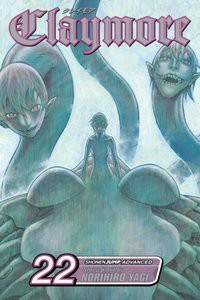
Vol. 22
(by Norihiro Yagi, Viz Media, $9.99)
FROM THE BACK COVER:
"In a world where monsters called Yoma prey on humans and live among them in disguise, humanity's only hope is a new breed of warrior known as Claymores. Half human, half monster, these silver-eyed slayers possess supernatural strength but are condemned to fight their savage impulses—or lose their humanity completely.
Rebel Claymores, the Organization that created them, and a host of reanimated top-level warriors clash with savage intensity. The Claymores' demonic impulses are provoked, threatening to destroy their human consciousness. Meanwhile, Hysteria, animated by blind vengeance, grows stronger with each attack against her. Is it possible that the rebels will be defeated by their long-dead comrades?"
EVIDENCE FOR:
Sometimes, all the world needs is a damned good fight scene—and that's exactly what this volume of Claymore gives us. It starts with two enraged rival Claymores breaking into their "awakened" form, pulls more and more fighters into it, and leads up to an epic bloodbath involving three giant monsters and nine Claymores all told. And it's not like this is a generic scream-until-your-powers-increase battle: the awakened creatures shift into multiple forms, the Claymores' attack formations keep changing, and the final killing move is a tactical masterpiece. The steady pacing, with characters charging forward, pulling back, then charging forward again with a new strategy, also keeps the momentum strong. Some last-minute surprises spice up the story, with certain long-gone characters suddenly resurfacing to bring the series (almost) full circle. Intense, carefully shaded artwork adds to the thrill of battle, with dense speedlines, a constant sense of motion, and death-defying acrobatics at every turn. Even the clenched jaws and narrowed eyes on the characters' faces contribute to the mood. And what's there to say about the awakened beings? They're hideous, yet awe-inspiring—exactly the kind of epic villain this series needs.
EVIDENCE AGAINST:
Sometimes, a damned good fight scene is not enough to carry a storyline for 180-plus pages. The beginning and middle of this volume end up hopelessly cluttered with the "everyone fighting everyone else" mentality, and it's not until the rebels appear that battle lines are drawn more clearly. Even then, the simultaneous action—a slugfest between Claymores who have literally gone "beast mode," and the rebels taking on Hysteria in a nine-on-one showdown—can be disorienting. Sudden scene transitions, inexplicable shifts in location, and characters who look dangerously similar all contribute to this mess. What's more, this over-the-top action is only one dimension of the entire series. The machinations of the Organization are skimmed over, the back-stories of various Claymores are left for another time, and the shocking truth of this world doesn't matter much when everyone's swinging swords and claws at each other. The art could also be rightfully accused of being one-dimensional: speedlines are awesome, but that's practically the only distinguishing feature of the visuals, along with angry Claymore faces and densely screentoned rocks. This is hardly a recipe for grand, imaginative fantasy.
FINAL VERDICT:
An amazing fight, to be sure, but it has too many confusing spots and shuts out all other elements of the story. That, along with monotonous artwork, make this a C.
LIMIT
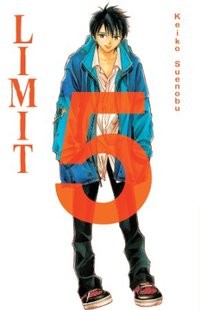
Vol. 5
(by Keiko Suenobu, Vertical, $10.95)
FROM THE BACK COVER:
"As a search-and-rescue party is now deep into the hunt for survivors, another young life has fallen seemingly from the hands of another. Tensions are high, but Mizuki feels she may have found brief solace in old acquaintance Haruaki. But her trust may soon be betrayed once again, when he reveals who may be behind a pair of murders since the bus crash, potentially driving the pair further into darkness."
EVIDENCE FOR:
Limit treads some daring new ground in Volume 5, testing the most basic notions of right and wrong. How does a well-intentioned person end up doing horrible things? Can sins of omission—glossing over a mistake, failing to speak up—be as evil as doing something bad on purpose? And how hard is it, really, to choose between what is right and what is easy? The answers to these questions lead to the emergence of an unlikely villain, and the resulting turns of plot are more tumultuous than ever. In just a few chapters, this storyline wrings out fear, grief, panic, disbelief, and slight twinges of hope, sometimes all at once. Furthermore, past mysteries and unexplained deaths finally come to light, revealing one shocker after another. The artwork shows great versatility in traversing this emotional storm: one moment it's light and feathery as the characters reflect on happier times, then shadows and darkness take over when awful truth of reality sets in. Keiko Suenobu also throws in visual metaphors, like a shadowy demonic figure, to get the point across—and sure enough, it enhances the impact of the story even further.
EVIDENCE AGAINST:
Everyone loves a good dramatic reveal, but Limit makes a lot of familiar mistakes as it drops the bombshells in this volume. Readers will have to sit through one of those dreaded villain monologues, where it takes dozens of pages to explain that "these are all the horrible things I did, and these are the horrible things I plan to do." What's more, the storyline halts and throws in several quick flashbacks to fill out the details, at a time when the plot ought to be charging forward with all the tension it's built up. Some of these explanations might also leave skeptical minds wondering about the physics of the situation—like how do you get a slash down your back that causes enough blood loss to be fatal? What's more, the sheer chaos of the storyline leads to some poor layout decisions, with panels that jump from one dramatic zoom-in after another. There might be a wide-open eye here, or a clutching hand there, but these disconnected body parts don't do much to describe what's going on physically.
FINAL VERDICT:
The story and layouts aren't always perfectly put together, but this volume packs enough twists and emotional extremes to be worthy of an A-.
THE SACRED BLACKSMITH
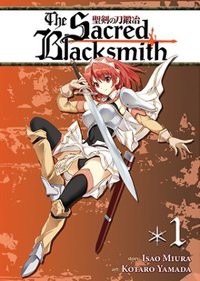
Vol. 1
(by Isao Miura and Kōtarō Yamada, Seven Seas, $13.99)
FROM THE BACK COVER:
"Like her father and grandfather before her, Cecily Campbell entered the noble ranks of the Knight Guard, sworn to protect the Independent Trade City of Housman. Now the time has come for Cecily to prove herself in battle. A veteran of the great Valbanill War goes berserk in the marketplace. Cecily confronts him with the prized sword she inherited from her father—and it shatters to pieces!
All seems lost, when a lone figure swoops to the rescue, an expert swordsman with a sword unlike any Cecily has ever seen. His name is Luke Ainsworth, a blacksmith of much renown, who will forge a new sword for Cecily and join her down a path of magical adventure beyond her wildest dreams."
EVIDENCE FOR:
The further in you go, the better it gets—that's Volume 1 of The Sacred Blacksmith in a nutshell. It starts out with the basic building blocks of the fantasy genre, but hones each of them to top quality: noble warriors, incredible weapons, terrifying beasts, and dashing swordplay. The artwork alone is impressive enough at the start, with lush countryside landscapes and elaborately-attired characters, and it gets more dynamic later on. Blood and limbs go flying, special attacks cut in from dizzying angles, and Luke steals the show with his "magical forging" technique in the climactic scene. But it's not just the surface details that make this series a winner; the imaginative world-building adds to the experience as well. A historic war, a forbidden form of gene-splicing magic, and a rich tradition of swordsmanship all add up to a satisfying premise. Several story elements also set up future tensions: the "monsters of the week" faced by Cecily and Luke might just be the seed of a greater plan, and Luke's prodigious ability has many mysteries wrapped up in it. The story already feels epic, and it's only just begun.
EVIDENCE AGAINST:
Creating a fantasy epic is always something of a gamble, as it's easy to scare people off with the sheer size of the world. Various fantasy names and places are discussed in this volume's opening chapter, and they even throw in the obligatory map with major cities and countries highlighted. What does any of this accomplish, aside from cluttering readers' minds with unnecessary detail? In addition, the series' original format as a novel is clear to see in the expository blocks of text. It makes no sense to put long, indigestible paragraphs in a manga, when the visuals themselves should be telling the story. The page layouts get off to a clumsy start too, with overly dramatic action scenes clashing against calmer (and sometimes even comedic) moments of medieval life. Somehow, Isao Miura can draw great individual panels, but doesn't know how to make them flow together—at least until the later chapters. Lastly, I'm not usually one to lecture about fanservice, but the fact that Cecily's armor is "magically dissolved" by demon sorcery is just silly.
FINAL VERDICT:
It's a ages-old formula set within a familiar genre, but the premise is solid enough, and the action exciting enough, to earn this volume a B.
SLAM DUNK

Vol. 28
(by Takehiko Inoue, Viz Media, $9.99)
FROM THE BACK COVER:
"With Sannoh pulling away with a big lead on the scoreboard in the second half, Shohoku is looking clearly outmatched. With the team foundering, Sakuragi decides he's got to get everyone fired up and boldly declares that he's going to take Sannoh down. Shohoku still has a long way to go, and Akagi himself needs to find a way to overcome Kawata's strong defense. But if Shohoku can find their rhythm, they just might get back in the game."
EVIDENCE FOR:
Oftentimes, manga is about bringing fantasy scenarios to life—and what could be more fantastical than an upstart basketball team mounting a 24-point comeback against the defending champs? This volume of Slam Dunk makes you believe that fantasy, with its compelling characters, realistic game strategy, and attention to detail. Artistically inclined readers will marvel over the subtle shading and beads of sweat on the characters' faces, while at the same time appreciating the perfectly posed anatomy and incredibly challenging angles that Takehiko Inoue draws from. (A direct overhead shot? Insanity!) Meanwhile, basketball aficionados will witness all the things that make the game great: a white-hot three-point shooting streak, a series of perfectly executed screen plays, and Sakuragi elevating the simple skill of rebounding into an art from. Lastly, any fan of a good underdog story will instantly get caught up in the adrenaline rush, as one player competes to the point of near-total exhaustion, shifting strategies keep everyone guessing, and Shohoku simply refuses to believe that the odds are stacked against them. That's the magic of the sports genre: sometimes, the impossible might just happen.
EVIDENCE AGAINST:
In this volume, Slam Dunk fans get a chance to witness the impossible ... or maybe just the impossibly slow. It seems that every moment on the court is now an exercise in time dilation, with entire chapters devoted to describing a single play. (Worse yet is the chapter between key plays, where a character might spend several pages pondering tactics in his head.) Slow-motion panels are great for heightening the drama of a particular moment, but when they start cropping up all the time, it's no longer special. Another major waste of time is the frequent use of crowd-reaction shots—okay, everyone's gawking at the amazing thing that just happened, no need to draw in every single minor character. Because of this obsession with game action, character development all but comes to a standstill—except for that one awkward moment where they try to shove in a flashback to explain the significance of a play that just happened. Looks like this Shohoku-Sannoh matchup is turning into a test of fortitude for the readers as much as it is for the players.
FINAL VERDICT:
It has plenty of exhilarating moments and standout visuals, but the way the game goes by so slowly—and with so little outside development—means a B- for this volume.

APOCALYPSE NO TORIDE (Fortress of the Apocalypse)

Vol. 1
(by Yuu Kuraishi and Kazu Inabe, Kodansha, ¥450)
FROM THE BACK COVER:
"Yoshiaki Maeda has been falsely imprisoned at Shouran Academy, a rehabilitation center for delinquents from around the Kanto region. Day after day, the violence swirling around Yoshiaki pulls him ever deeper into despair. But suddenly, within the facility, undead man-eating zombies emerge! In this nightmarish world, delinquents begin a fight for survival!!"
EVIDENCE FOR:
In an age where the zombie genre has been cross-bred with comedy, romance, science fiction, and everything else, sometimes you just want to get back to basics—which is what Apocalypse no Toride does. This is zombie horror in pure, undiluted form, with the infected digging their teeth into victims, survivors running about in panic (before being eaten), and the main characters fighting with any weapon they can get their hands on. The prison setting adds an extra layer of doom and gloom; the fact that it's a closed-off environment makes it that much more challenging for Yoshiaki and his cellmates to survive the ordeal. Plus, if the rapid zombie-fication of the prison inmates isn't bad enough, the changes in the outside world are even more terrifying. Gruesome, highly detailed art plays a big part in making the series as effective as it is, with streams of blood, half-eaten bodies, and dead-eyed faces bringing the classic zombie formula to life. Meanwhile, the drastic actions of the series' protagonists—rushing to warn others, beating up the undead, and taking charge of the prison—are just as visually thrilling, thanks to crisp linework and striking angles.
EVIDENCE AGAINST:
Wait a minute, isn't this Highschool of the Dead? Except in a prison? Anybody familiar with the most well-known zombie work in modern manga and anime—which is to say, a lot of people—will notice the similarities instantly. We're not just talking about general concepts that are common to the zombie genre, but specific plot points like running to the roof or commandeering a passenger vehicle. As a result, the events of first volume aren't as shocking as they could have been, because other protagonists from other stories have done it already. And even those who aren't playing "spot the ripoff" may find the content too predictable: aside from running, fighting, or getting infected, there just aren't many other options for the victims of a zombie apocalypse. In fact, Yoshiaki's presence as the main character doesn't even seem to matter past a certain point, as escaping the zombies becomes more important. The artwork can also be just as plain and predictable as the story: lots of blank backgrounds during non-action scenes, forgettable character designs outside of the main cast, and the same bloody corpses ambling about in every scene.
FINAL VERDICT:
When it comes to zombies, you know exactly what you're getting, which both helps and hurts this series. It's terrifying, it's violent, it's addictive ... and it's also exactly like most other zombie sagas.
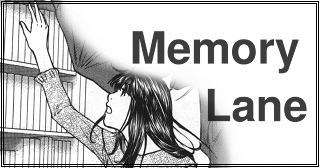
BLUE

(by Kiriko Nananan, Fanfare / Ponent Mon)
At the height of the last boom (the mid-to-late 2000's), the monocles-and-caviar arthouse manga crowd wouldn't shut up about the obscure yet amazing catalog of Fanfare / Ponent Mon. (Two companies, one name, awkward punctuation mark.) Nowadays, the buzz is quieter, but Fanfare is still in business—although whether you can purchase everything they've ever produced is a different question. Kiriko Nananan's Blue has been out of print for a while and goes for around US$40 on Amazon's secondary market, which is a crying shame, because this already hard-to-get title is now even more inaccessible.
The story, though, is perfectly accessible—at its foundation, it's a basic high school romance. However, it's told in such a subtle style that it can make hearts break with a single line of text, or a single panel, or even a twist of a smile from the main character. Blue tells the story of Kayako Kirishima, an ordinary high-schooler who falls for free-spirited classmate Masami Endo—even though the thought of girls liking other girls never really crossed her mind before. The great thing about Blue is that, even though it's labeled as yuri, that's never really the point: it doesn't sensationalize the relationship a la Strawberry Panic!, nor does it have the whirling teen angst of Milk Morinaga's work. It simply says, here are two girls who like each other, but they have personal circumstances that will prevent it from working out.
Kayako's careless dealings with other friends, including a particular boy, endangers her relationship with Masami, while Masami's questionable past catches up to her and racks her with guilt until she admits to the truth. That's it; that's the conflict they have to work through. However, the sparse approach of the manga—no silly beach trips, no unexpected twists, just talking about their feelings—distills every emotion to its most concentrated form. The artwork, too, is boiled down to the barest minimum of expression: absolute black-and-white linework, only the briefest hints of backgrounds, and carefully laid out panels that say more in the white spaces than the action itself. This single volume goes by fast, but when it's all over, it'll feel like having experienced a lifetime of feelings.
discuss this in the forum (5 posts) |